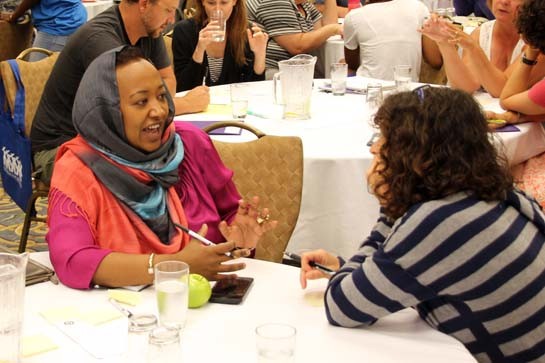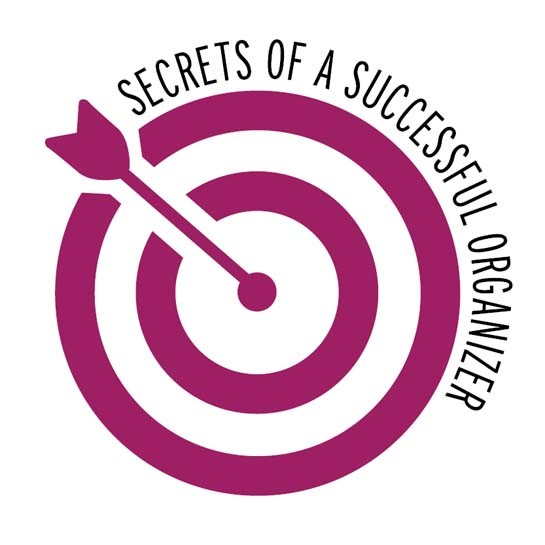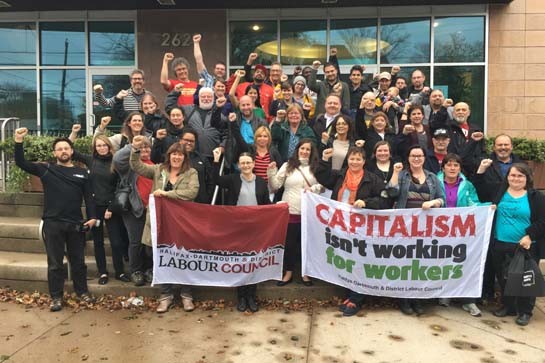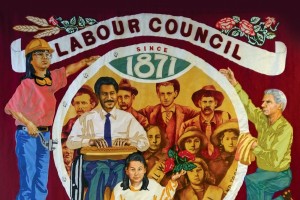The secret is out — Secrets of a Successful Organizer is a manual already finding widespread application after its release in early 2016. A Labor Notes book by Alexandra Bradbury, Mark Brenner, Jane Slaughter and many others from the self-described "media and organizing project," it was released in March 2016 and needed a second printing by September. Geared toward creative use rather than passive consumption, Secrets advises its readers from the start: "For best results, read together. Try the exercises. Use the handouts."

Sonia Singh is an organizer with Labor Notes. PHOTOGRAPH: LORRAINE ENDICOTT
Sonia Singh is a Labor Notes organizer who designed and helped compile Secrets. She also conducted a workshop based on the book at the Halifax-Dartmouth & District Labour Council's 2016 Troublemakers' Conference in Nova Scotia. "We tend to break up the areas of the labour movement to share amongst ourselves, because a lot of our work at Labor Notes is about building relationships with activists and rank-and-file activists around the States but also in Canada," she says, explaining how she came to the facilitator role.
"My background being from Canada, being an organizer in Ontario, has meant that one of my areas has been building those networks in relation to the Canadian labour movement."
While she now works out of Labor Notes' base in Brooklyn, Singh's background includes 12 years of considerable Canadian content. "I worked in Toronto for many years at the Toronto Workers' Action Centre," she tells Our Times. "That's not a union but a workers' centre that works with a really diverse range of low-wage, non-union members. It generally has a focus on organizing through building membership and getting people connected to the centre, and then connecting with campaigns like the one right now, for a $15 minimum wage and labour law reform, called the Fight for $15 and Fairness." Singh was also involved with Justice for Migrant Workers, helping farm workers organize in rural Ontario.
Troublemakers' Conference participants discussed ways in which they and others were employing Secrets. Singh says much of successful organizing comes down to neglected essentials like talking with co-workers. "How to have an organizing conversation — you know, what does it mean to talk to someone about what they care about, and really listen more than you speak, and ask probing questions to really get at what is bothering them."
She says "That process is a way to generate hope and a plan to help change that issue." Apathy among union members can be countered with this approach, in which a sincere outreach effort is an antidote to lack of involvement and interest.
"That's something I found when talking to people who didn't have a union and we were trying to, for cleaners or construction workers, use those tools as an organizer in that setting," adds Singh. "I know of people going to farm workers' bunkhouses and talking to people, hearing what it is that concerns them, going through those steps.
"Regardless, even in those kinds of settings, those basic ingredients are still there, that's why through the book we try to make it very hands-on, so people are walked step by step through how to have an organizing conversation. It's a big component of our training as well — we just sort of wanted to try to drill down into that point, 'how do you know what people care about?' You have to talk to them and move them through that conversation."

John Smith, president of the Elementary Teachers of Toronto, says if teachers are going to “have strength in bargaining and have an influence on building a strong public education system, then we need everyone mobilized.” PHOTOGRAPH: STEPHEN MICHALOWICZ
Talk isn't cheap when it leads to organizing and action. John Smith, president of the Elementary Teachers of Toronto (ETT), says his union is using Secrets' methods in conjunction with other resources and training. "Essentially, we're an 11,000- member union and maybe 200 people run this union," he explains, citing the need to better involve members.
"We have lots of committees, member committees; we work toward member engagement. We actually don't have very many members who are deeply engaged in working within the union. This became apparent when we were on our last work- to-rule, where we found many teachers were on work-to-rule for six months but couldn't really explain why they were on work-to-rule when we conducted outreach to the community, for example."
Why bother trying to change the views of members who show little or no interest in their own union? Smith says this sizable group can be valuable when reminded of its own power.
"If we are going to mobilize and if we are going to organize, and have strength in bargaining and have an influence on building a strong public education system, then we need everybody mobilized; everybody knowing what the issues are; talking to parents about the issues; talking to the community; and pressuring the government or the school board when we're in negotiations." He's optimistic that the tools found in Secrets can help reverse the apathy, one worker at a time.
"We actually need to reach out and have conversations, with every member, so that's what we've been doing — we just finished our second round of training teachers," Smith shares. "We have about 60 teachers now trained in having those organizing conversations. Meeting with individual teachers, each conversation takes about 20 minutes."
IDENTIFYING MEMBERS' CONCERNS
Then there's the process of data collection and analysis from those one-on-one talks, moving toward uncovering what individual members are willing to contribute to accomplishing goals they deem important. That will mean 11,000 organizing conversations within the Elementary Teachers of Toronto; Smith says the 60 original teachers will be joined by another 20 to 30 expected to be trained in early 2017.
As the conversations expand in scope, the union will benefit from greater inclusion and responsiveness to individual members' concerns, notes Smith. "Some of the issues that come up locally in each school can then be dealt with collectively by those teachers because the issues would have been identified, and the ETT can also identify those issues that we want to put on the table for bargaining, local bargaining with the Toronto School Board, but also provincial bargaining with the education ministry."
The process is slow and one can easily joke that it adds extra labour to the labour movement. But the focus on reaching out at a personal level matters, argues Smith. The trained member-organizers "start by organizing their own school, which might have between 15 and 30 teachers, and they then go to the schools nearby and organize those schools, have conversations at those schools."
The role is different from that of the shop steward and does not replace the steward, although, as he adds, some stewards have come forward as member-organizers as well. "Many teachers who are not involved in being stewards have volunteered for it and the first training of the summer was a three-day commitment. The one that we held in early December was about a two-and-a-half-day commitment to be trained." What was expected to be finished by the end of December 2016 is ongoing because of the time-consuming nature of the "organic conversations" conducted by these specially trained members across 400 worksites.
ORGANIZING THE ORGANIZED
It's the effectiveness and solidarity-building that makes the method worth it, observes the ETT president. "Member-organizers identify one or two issues in that school where everybody is frustrated. What are we going to do about it? How can we plan to take power in that situation or assert ourselves?" asks Smith, before offering a compelling example of how teachers were able to resolve a problem together: "Some schools demand that teachers sign in, in the morning. Sign in a book. A complete waste of time, micromanaging — a trip to the office that people don't need to take. They're busy enough as it is. It's very, very frustrating. There's actually no reason for doing it, so the organizers identified that as one of the issues and they had a union meeting, decided this was an issue.
"The next morning they assembled in the parking lot, walked in together and refused to sign. So then the sign book disappeared! It's a tiny little thing, but there are a number of those kinds of victories going on, once we identify some common issues in a school and then people organize around that issue."
ORGANIZING THE UNORGANIZED
In some cases, the workers and organizers using Secrets training are not yet unionized. Dahlia Alie is a rank-and-file organizer at GoodLife Fitness in Toronto. She's a group fitness instructor with the chain. "A bunch of us got together initially — the committee members — and we determined that we wanted to unionize because we weren't happy with our working conditions." Personal trainers and group fitness instructors formed two different bargaining units, following a mediated settlement at the Ontario Labour Relations Board.
A delay accompanied the union's efforts to bring group fitness instructors into its original drive to organize GoodLife personal trainers. During this time, Alie says she realized that organizing "was something that [she] had a passion for."
She speaks positively about her experience with Secrets. "The book has been coming in very handy in terms of identifying the different types of people — you know, the people who sit on the fence and need a convincing argument; the people who are gung-ho and are like 'let's go — we need this!'; others who are like not only 'how can I sign up?' but 'how can I do this too?'" she says. Secrets has proved helpful in "just being able to identify key people in the workplace who are respected and have influence with the other employees and with mobilizing people in different ways to participate."
Workers United is helping with unionization efforts at GoodLife, and originally suggested the book. Organizer Tanya Ferguson even gave Ali her own copy of Secrets: "It's all highlighted and written-in and flagged!" laughs Alie. "I really find that the book does an excellent job of diagnosing the different aspects of union organizing and goes step by step on how to get the job done, what to expect. Above all else, it's really talking about cultivating relationships."
FINDING WORKPLACE LEADERS
Ensuring members understand what is involved in pursuing a union is important, which is one reason why finding natural workplace "leaders" and recruiting them to the cause is a major tool in Secrets.
Leaders are those influencers who already help shape attitudes and transmit information across the workplace, for better or worse. Identifying them is a process, suggests Alie: "Who are the people in their department, in this company, who are in a position to affect these desired changes? Also who are the influencers in the company, in terms of who will the employees listen to in developing a course of action?"
When a core group of union members and member-organizers, particularly these leaders, listens to co-workers and really hear what they are saying, something very positive happens for all involved. Alie says what were regarded as private grievances become a rallying point for collective action as members realize "You know what? You're not being a rabble-rouser — you're entitled to have some sense of job satisfaction and safety in your workplace, and fairness as far as remuneration is concerned."
YOU WIN SOME, YOU LOSE SOME
Yet as the Labor Notes book states, "One hard reality about organizing [is that] you're going to fail a lot. You'll lose more often than you win. That doesn't mean you're doing it wrong."
Alie stresses that there can be very specific reasons for apparent failures. She teaches four group fitness classes a week at three different GoodLife locations, which can make communication tougher. "We don't all show up to the same location every single day from morning to evening to do the job. We rotate in and out. I literally sometimes don't see my fellow instructors."
Some staff have expressed genuine fear of being fired or reprimanded: "People can be very excited over the phone and lined up, ready to sign union cards, but there are times not many people will show up." Organizing with these considerations in mind is different from attempting to engage ideologically anti-union or apathetic workers.
"We all know co-workers who have been victims of retaliation — they've lost their jobs, they've been told they have to pay money back to the company," she adds; non-compete clauses in contracts can make finding other work difficult. She also points to the fact that "There's been nothing of this kind in Canada, ever: Fitness professionals wanting to form their own union. We were the first and you kind of cut your teeth on the first, right?"
Open lines of communication among members can help turn a bad experience at work into a catalyst for change. "I find a lot of the ones who are not receptive to unionization in the very beginning turn around and are receptive when, unfortunately, they become the victim of treatment that we're trying to get rid of," observes Alie. Group fitness instructors are witnessing the personal trainers, now unionized, experiencing illegal retaliation from GoodLife, but also seeing the benefits of being part of a bigger struggle. "Because they are now unionized, they are able to pick up the phone and call their steward and alert them to what's going on," says the organizer.

The Elementary Teachers of Toronto held a summer institute last year as a first step towards building a movement for high member participation. PHOTOGRAPH: STEPHEN MICHALOWICZ
It's crucial to point out that member-organizers are undertaking a task distinct from existing forms of member outreach. "We have a lot of structures in this union to communicate with our members — we have an electronic mailing list with everybody's email on it, we have dozens of meetings, dozens of committees, we go out to schools every day — the executive — and have school meetings," says John Smith.
"But it's frustrating because we're still not hearing from people, you know, actually having relationships with people, involving them in the union, and some of the conversations are about that. But we also need to identify who is powerful in the union, which is a difficult one for us to get our heads around, because the steward is theoretically the powerful person in the union, but they might not be a respected person in the school, you know? A respected person in the school might actually hate the union, but that person might also want to see lower class sizes and doesn't want to have to sign in, in the morning, right? If that person says, 'this is a good idea, let's do it,' it influences a number of people in the school."
EXPANDING THE POOL OF ACTIVISTS
Sonia Singh mentions a bonus of sharing the responsibilities of workplace organizing. "Sometimes there is a crossover, but even where there is a shop steward who's really active, if you talk to someone who is really in the core of that 'bullseye,'" — Singh is referring to the model of organizing recommended in Secrets — "and doing all this work, they're often feeling pretty burnt out, and that they need some more people on the team. So even where we have people who are very active in the union, we need more — we can't just do this with a small club."
She's unsure exactly how many training sessions Secrets has been used in, even as she's just completed another at the time of her Our Times interview. It's being used at non-union workers' centres and by unions, as well as at various Troublemakers' Conferences affiliated with Labor Notes.
"I was just in Toronto doing the second round with the elementary school teachers, which was really exciting," Singh says. "That's another 26 organizers we just trained this week. Now there's 75 who have been trained."
The book's training handouts are available free via the Labor Notes website, a fact Singh wants to publicize to labour educators and anyone else interested.
"We wanted to keep the book a toolkit — something that people would not just read, but use and try out. I think it speaks to a need: that people are doing some really important organizing and facing a lot of challenges in the process. Definitely in the States the context is a little different than Canada, but I feel like those challenges translate across the border as well."
Social media is not always an accurate barometer of how well a message is being shared among members, although Singh says the power of social media is not to be ignored either. Overcoming division, whether brought about by the boss or factors like racism or language barriers on the shop floor, is best addressed by actual conversation.
"It's a different way of thinking about these issues, so that we aren't just relying on the executive officers and grievance procedures to solve problems but we can take on something together, and in doing so, do it visibly, in a way that's going to build people's confidence," says the thoughtful organizer. "We probably have all had these experiences where we see the power of collective action, so how do we keep going? We can't stop at just one!"
_______________________________________________________

SIDEBAR
AIM FOR THE BULLSEYE
From the organizer's point of view, think of your fellow members distributed on a dartboard.
In the centre is your core group: the people (maybe you?) who are always thinking about organizing and how to get others involved, even on their time off. They might be elected leaders or shop stewards, or not.
In the first ring are the activists who can be counted on to help when an issue heats up. They will take responsibility to get the word out and will ask other people to take action, too.
In the second ring are supporters: people who will wear a button or sign a petition, but don't take responsibility for getting anyone else involved.
In the third ring are the people who appear most disengaged. They don't see the union as a factor in their lives, so they don't participate.
There are also people outside the circle who aren't just uninvolved — they're hostile to the union. Don't waste your time arguing with the haters. Maybe one day something will open their eyes, but it'll probably be an experience, not a debate, that does it.
LABOR NOTES: Secrets of a Successful Organizer
Melissa Keith is a former radio broadcaster and an award-winning freelance journalist. She lives in Lower Sackville, Nova Scotia.















